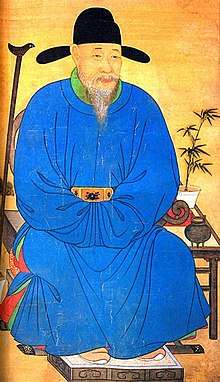Jwauijeong
The Jwauijeong [tɕwa ɰi tɕʌŋ] was the Second State Councillor[1][2] of the Uijeongbu (State Council), subordinate in rank only to the Yeonguijeong, during the Joseon Dynasty of Korea (1392 -1910).[3] Only one official was appointed to the position and was variously referred to as Jwasang, Jwajeongseung, Jwagyu, Jwahap, or Jwadae.[3]
| Jwauijeong | |
 Portrait of Ha Yeon who served as Jwauijeong during the King Sejong's reign. | |
| Korean name | |
|---|---|
| Hangul | 좌의정/ 좌상/ 좌정승/ 좌규/ 좌합/ 좌대 |
| Hanja | |
| Revised Romanization | Jwauijeong[1]/ Jwasang / Jwajeongseung / Jwagyu / Jwahap / Jwadae |
| McCune–Reischauer | chwaŭijŏng / chwasang/ chwakyu / chwahap / chwadae |
Since its foundation, the Joseon Dynasty, which had succeeded to the state apparatus of the Goryeo Dynasty (918 – 1392), had been adjusting its government organization. In 1400, the second year after King Jeongjong came to the throne, he renamed the Dopyeonguisasa (都評議事司; Privy Council[4]), the highest organ in charge of the state affairs of Goryeo, to Uijeongbu and created the post of Jwauijeong along with that of Uuijeong (Third State Councillor[5]). The three officials were collectively referred to as the Samjeongseung (Three top officials[6]) or the Samuijeong (Three High Councilors).[3]
See also
- Yukjo
- Joseon Dynasty politics
- History of Korea
References
- "좌의정(左議政 ), Jwauijeong" (in Korean and English). The Academy of Korean Studies. Retrieved 2009-01-31.
- Choi (2006), The Origin of the Roman Catholic Church in Korea p. 372
- 좌의정 (左議政) (in Korean). Empas /EncyKorea. Retrieved 2009-01-31.
- "도평의사사 (都評議使司), Dopyeonguisasa" (in Korean and English). The Academy of Korean Studies. Retrieved 2009-01-31.
- "우의정(右議政), uuijeong" (in Korean and English). The Academy of Korean Studies. Retrieved 2009-01-29.
- "정승(政丞), Jeongseung" (in Korean and English). The Academy of Korean Studies. Retrieved 2009-01-29.
- Lee, Ki-Baik (1984). A New History of Korea. Harvard University Press. ISBN 0-674-61575-1.
- Choi, Jai-Keun (2006). The Origin of the Roman Catholic Church in Korea. The Hermit Kingdom Press. ISBN 1-59689-064-9.